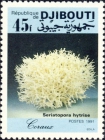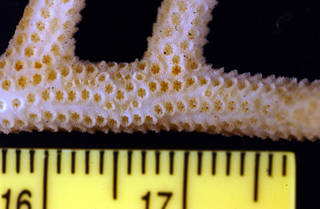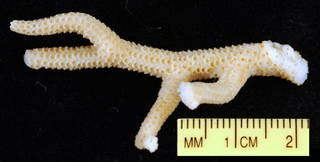
| Intro | | About | | Wiki | | Search traits | | Data explorer | | Literature | | Definitions | | Sources | | Webservices | | Statistics | | Feedback | | Editors | | Log in |
WoRMS taxon detailsSeriatopora hystrix Dana, 1846
206973 (urn:lsid:marinespecies.org:taxname:206973)
accepted
Species
Seriatopora angulata Klunzinger, 1879 · unaccepted > junior subjective synonym
Seriatopora caliendrum var. subtilis Nemenzo, 1964 · unaccepted > junior subjective synonym
marine,
Dana, J.D. (1846-1849). Zoophytes. United States Exploring Expedition during the years 1838-1842. <em>Lea and Blanchard, Philadelphia.</em> 7: 1-740, 61 pls. (1846: 1-120, 709-720; 1848: 121-708, 721-740; 1849: atlas pls. 1-61)., available online at https://www.biodiversitylibrary.org/page/18989497, http://www.sil.si.edu/digitalcollections/usexex/navigation/ScientificText/USExEx19_08select.cfm [details]
Note Red Sea (Veron, 1986).
Unreviewed
Type locality Red Sea (Veron, 1986). [details]
Description Colonies are small bushes or tangles of thin branches up to about 25 cm across on fore-reef slopes. In sheltered,...
Description Colonies are small bushes or tangles of thin branches up to about 25 cm across on fore-reef slopes. In sheltered, sedimented or lagoonal areas, however, colonies reach 1 m across. Branches are usually 1-4 mm thick and are sharply pointed and fragile. The linear alignment of calices is very noticeable, and calices are markedly oval in most cases. S. hystrix occurs over a wide range of depths, but is particularly abundant in shallow water in sheltered conditions. It is most abundant in back reef of lagoonal areas where colonies can cover up to 30% of the substrate (Sheppard, 1998). Branches are tapered to a point; they may be either widely spaced or compact. Colour: cream, blue or pink. Abundance: common in all shallow reefal environments (Veron, 1986). Easily recognisable. Fine branches (1.5-4.5 cm thick) with tapering tips; corallites (up to 1.5 mm across) in neat rows, slightly hooded. Forms compact shrub-like colonies. Colour: delicately coloured in cream, blue or pink. Habitat: shallow outer reef areas and sheltered inner algal and seagreas beds (Richmond, 1997); rocks (Kalk, 1959). [details]
Hoeksema, B. W.; Cairns, S. (2025). World List of Scleractinia. Seriatopora hystrix Dana, 1846. Accessed through: World Register of Marine Species at: https://www.marinespecies.org/aphia.php?p=taxdetails&id=206973 on 2025-07-16
Date action by 2000-09-28 07:24:50Z changed Garcia, Maria
Nomenclatureoriginal description
Dana, J.D. (1846-1849). Zoophytes. United States Exploring Expedition during the years 1838-1842. <em>Lea and Blanchard, Philadelphia.</em> 7: 1-740, 61 pls. (1846: 1-120, 709-720; 1848: 121-708, 721-740; 1849: atlas pls. 1-61)., available online at https://www.biodiversitylibrary.org/page/18989497, http://www.sil.si.edu/digitalcollections/usexex/navigation/ScientificText/USExEx19_08select.cfm [details] original description (of Seriatopora angulata Klunzinger, 1879) Klunzinger CB. (1879). Die Korallthiere des Rothen Meeres, 2. Theil: Die Steinkorallen. Erster Abschnitt: Die Madreporaceen und Oculinaceen. <em>Gutmann, Berlin.</em> pp. 1-88, pls. 1-10. [details] original description (of Seriatopora caliendrum var. subtilis Nemenzo, 1964) Nemenzo, F. (1964). Systematic studies on Philippine shallow-water scleractinians: V. Suborder Astrocoeniida (Part. <em>Natural and Applied Science Bulletin, University of the Philippines.</em> 18: 193-223. [details] basis of record Veron JEN. (1986). Corals of Australia and the Indo-Pacific. <em>Angus & Robertson Publishers.</em> [details] Othercontext source (Hexacorallia)
Fautin, Daphne G. (2013). Hexacorallians of the World. (look up in IMIS) [details]
additional source Veron JEN, Pichon M. (1976). Scleractinia of Eastern Australia. Part I. Families Thamnasteriidae, Astroceoniidae, Pocilloporidae. <em>Australian Institute of Marine Science Monograph Series.</em> 1: 1-86. [details] additional source Vaughan TW. (1918). Some shallow-water corals from Murray Island (Australia), Cocos-Keeling Island, and Fanning Island. <em>Papers from the Department of Marine Biology of the Carnegie Institution of Washington.</em> 9 (213): 49-234, pls. 20-93. [details] additional source Quelch J.J. (1886). Report on the Reef-corals collected by H.M.S. 'Challenger' during the years 1873-76. <em>Report on the Scientific Results of the Voyage of H.M.S. Challenger during the years 1873–1876. Zoology.</em> 16 (46): 1-203, pls 1-12., available online at http://www.19thcenturyscience.org/HMSC/HMSC-Reports/Zool-46/README.htm page(s): 16, 17, 62, 202 [details] additional source Dana, J.D. (1846-1847). On Zoophytes. <em>The American Journal of Science and Arts, Second Series.</em> 2(4): 64-69; 2(5): 187-202; 3(7): 1-24; 3(8): 160-163; 3(9): 337-347. New-Haven., available online at https://www.biodiversitylibrary.org/page/28135503 page(s): 519, 521 [details] additional source Cairns, S.D., B.W. Hoeksema & J. van der Land. (1999). Appendix: List of extant stony corals. <em>Atoll Research Bulletin.</em> 459: 13-46. page(s): 37 [details] additional source Randall RH. (2003). An annotated checklist of hydrozoan and scleractinian corals collected from Guam and other Mariana Islands. <em>Micronesica.</em> 35-36: 121-137. page(s): 127 [details] additional source Cairns, S.D., B.W. Hoeksema & J. van der Land. (2007). as a contribution to UNESCO-IOC Register of Marine Organisms. (look up in IMIS) [details] additional source Liu, J.Y. [Ruiyu] (ed.). (2008). Checklist of marine biota of China seas. <em>China Science Press.</em> 1267 pp. (look up in IMIS) [details] Available for editors additional source Veron JEN. (2000). Corals of the World. Vol. 1–3. <em>Australian Institute of Marine Science and CRR, Queensland, Australia.</em> [details] additional source Veron JEN. (2002). New species described in Corals of the World. <em>Australian Institute of Marine Science Monograph Series.</em> 11: 1-209. page(s): 80, 82 [details] additional source Scheer G, Pillai CSG. (1974). Report on Scleractinia from the Nicobar Islands. <em>Zoologica, Stuttgart.</em> 42(122): 1-75. page(s): 7, 11, 13, 75 [details] additional source Umbgrove JHF. (1940). Madreporaria from the Togian Reefs (Gulf of Tomini, North-Celebes. <em>Zoologische Mededelingen, Leiden.</em> 22: 265-310. page(s): 270, 272, 308, Pl. XXI [details] additional source Umbgrove JHF. (1939). Madreporaria from the Bay of Batavia. <em>Zoologische Mededelingen, Leiden.</em> 22: 1-64. page(s): 8, 9, 14, 17, 20-21 [details] additional source Yabe H, Sugiyama T, Eguchi M. (1936). Recent reef-building corals from Japan and the South Sea Islands under the Japanese mandate. I. <em>The Science reports of the Tôhoku Imperial University, Sendai, 2nd Series (Geologie).</em> Special Volume 1: 1-66, pls. 1-59. page(s): 12 [details] additional source Yabe H, Sugiyama T. (1935). Revised list of the reef-corals from the Japanese seas and of the fossil reef corals of the raised reefs and the Ryukyu limestone of Japan. <em>Journal of the Geological Society of Japan.</em> 42: 379-403. page(s): 392, 402 [details] additional source Crossland C (1952) Madreporaria, Hydrocorallinae, Heliopora and Tubipora. Scientific Report Great Barrier Reef Expedition 1928-29 VI(3): 85-257. page(s): 90, 99 [details] additional source Nemenzo, F. (1964). Systematic studies on Philippine shallow-water scleractinians: V. Suborder Astrocoeniida (Part. <em>Natural and Applied Science Bulletin, University of the Philippines.</em> 18: 193-223. page(s): 194, 202, Plate 3 Fig 2 [details] additional source Pichon, M.; Benzoni, F. (2007). Taxonomic re-appraisal of zooxanthellate Scleractinian Corals in the Maldive Archipelago. <em>Zootaxa.</em> 1441: 21–33. page(s): 27 [details] additional source Bedot M (1907) Madreporaires d'Amboine. Revue Suisse de Zoologie 15: 143-292, pls. 5-50. page(s): 154-157 [details] additional source Brüggemann, F. (1877). Notes on the stony corals in the collection of the British Museum. I. Description of two new species of Turbinariidae. II. Remarks on the species of Seriatopora. <em>Annals and Magazine of Natural History, Series 4.</em> 19: 415–421. [details] additional source Veron JEN, Marsh LM. (1988). Hermatypic corals of Western Australia : records and annotated species list. <em>Records Western Australian Museum Supplement.</em> 29: 1-136., available online at https://doi.org/10.5962/bhl.title.60555 page(s): 34, 37 [details] additional source Boshoff, P.H. (1981). An annotated checklist of Southern Africa Scleractinia. <em>Oceanographic Research Institute Investigational Report, Durban.</em> 49: 1-45. page(s): 14 [details] additional source Umbgrove JHF. (1924). Report on Plistocene and Pliocene corals from Ceram. <em>Geological, Petrographical, and Paleontological Results of explorations carried out from September 1917 till June 1919 in the island of Ceram, Second Series: Palaeontology.</em> 1: 1-22, map, pls. 1-2. [details] additional source Goulet, T. L.; Cook, C. B.; Goulet, D. (2005). Effect of short-term exposure to elevated temperatures and light levels on photosynthesis of different host-symbiont combinations in the Aiptasia pallidal Symbiodinium symbiosis. Limnol. Oceanogr., 50(5): 1490-1498 page(s): 1495 [details] additional source Veron, J. E. N. (2000). Corals of the World, Volume II: Families Astrocoeniidae, Pocilloporidae, Euphyllidae, Oculinidae, Meandrinidae, Siderastreidae, Agariciidae, Fungiidae, Rhizangiidae, Pectiniidae, Merulinidae, Dendrophylliidae, Caryophylliidae. Australian Institute of Marine Science. Townsville., volume 2, pp. 429. page(s): 48-49 [details] additional source Ryland, J. S. (1981). Reefs of southwest Viti Levu and their tourism potential. Proceedings of the Fourth International Coral Reef Symposium, 1, 293-298 page(s): 296-297 [details] additional source Maier, E.; Tollrian, R.; Rinkevich, B.; Nürnberger, B. (2005). Isolation by distance in the scleractinian coral Seriatopora hystrix from the Red Sea. Marine Biology, 147, 1109-1120 page(s): 1109-1112, 1115-1117 [details] additional source Studer, T. (1901). Ergebnisse einer Reise nach dem Pacific (Schauinsland 1896-1897). Madreporarier von Samoa, den Sandwich-Inseln und Laysan. Zoologische Jahrbücher Abteilung für Systematik, 14, 388 page(s): 389 [details] additional source Wells JW. (1954). Recent corals of the Marshall Islands: Bikini and nearby atolls, part 2, oceanography (biologic). <em>U.S. Geological Survey Professional Paper.</em> 260(I): 385-486. page(s): 390, 411, plate 96 [details] additional source Pillai CSG. (1983). Structure and generic diversity of recent Scleractinia of India. <em>Journal of the Marine Biological Association of India.</em> 25, 1-2, 78-90. page(s): 83 [details] additional source Sheppard, C. R. C. (1985). Fringing reefs in the southern region, Jeddah to Jizan. Fauna of Saudi Arabia, 7, 37-58 page(s): 45 [details] additional source Reinicke, G. B.; Schuhmacher, H. (1996). Significance of different traits of soft-coral assemblages (Octocorallia, Alcyoniina) in benthic reef communities of the Red Sea. Göttinger Arbeiten zur Geologie Paläontologie, Sb2, 77-84 page(s): 78, 80 [details] additional source Hellberg, M. E.; Taylor, M. S. (2002). Genetic analysis of sexual reproduction in the dendrophylliid coral Balanophyllia elegans. Marine Biology, 141, 629-637 page(s): 634 [details] additional source Kühlmann, D. H. H. (2006). Die Steinkorallensammlung im Naturhistorischen Museum in Rudolstadt (Thüringen) nebst ökologischen Bemerkungen. Rudolstädter Naturhistorische Schriften, 13, 37-113 page(s): 44, 61, 65, 66-67, 112 [details] additional source Wallace, C. C.; Fellegara, I.; Muir, P. R.; Harrison, P. L. (2009). The scleractinian corals of Moreton Bay, eastern Australia: high latitude, marginal assemblages with increasing species richness. Memoirs of the Queensland Museum, 54, 2 page(s): 7 [details] additional source Dana, J. D. (1849). Atlas. Zoophytes. C. Sherman. Philadelphia., pp. 12-01 page(s): 10, 21 [details] additional source Fan, T. Y.; Lin, K. H.; Kuo, F. W.; Soong, K.; Liu, L. L.; Fang, L. S. (2006). Diel patterns of larval release by five brooding scleractinian corals. Marine Ecology Progress Series, 321, 133-142 page(s): 133, 134, 135, 136, 137, 138, 139, 140 [details]  Present Present  Present in aphia/obis/gbif/idigbio Present in aphia/obis/gbif/idigbio  Inaccurate Inaccurate  Introduced: alien Introduced: alien  Containing type locality Containing type locality
Nontype (of Seriatopora angulata Klunzinger, 1879) IGPS 38879, geounit Micronesian Exclusive Economic Zone [details]
Nontype (of Seriatopora angulata Klunzinger, 1879) IGPS 48742, geounit Marshall Islands Exclusive Economic Zone [details]
Nontype (of Seriatopora angulata Klunzinger, 1879) IGPS 48743, geounit Marshall Islands Exclusive Economic Zone [details]
Nontype (of Seriatopora angulata Klunzinger, 1879) IGPS 50753, geounit Palau Exclusive Economic Zone [details]
Nontype (of Seriatopora angulata Klunzinger, 1879) IGPS 51011, geounit Micronesian Exclusive Economic Zone [details]
Nontype (of Seriatopora angulata Klunzinger, 1879) IGPS 53041, geounit Palau Exclusive Economic Zone [details]
Nontype (of Seriatopora angulata Klunzinger, 1879) IGPS 53231, geounit Micronesian Exclusive Economic Zone [details]
Nontype (of Seriatopora angulata Klunzinger, 1879) IGPS 53262, geounit Micronesian Exclusive Economic Zone [details]
Nontype (of Seriatopora angulata Klunzinger, 1879) IGPS 54040, geounit Micronesian Exclusive Economic Zone [details]
Nontype (of Seriatopora angulata Klunzinger, 1879) MSI C-312, geounit Philippine Exclusive Economic Zone [details]
Nontype (of Seriatopora angulata Klunzinger, 1879) MSI C-471, geounit Philippine Exclusive Economic Zone [details]
Nontype HLD X2: 127-15, geounit Indian Exclusive Economic Zone [details]
Nontype IGPS 39177, geounit Japanese Exclusive Economic Zone [details]
Nontype IGPS 39366, geounit Japanese Exclusive Economic Zone [details]
Nontype IGPS 39384, geounit Japanese Exclusive Economic Zone [details]
Nontype IGPS 47179, geounit Japanese Exclusive Economic Zone [details]
Nontype IGPS 48607, geounit Japanese Exclusive Economic Zone [details]
Nontype IGPS 49739, geounit Northern Mariana Exclusive Economic Zone [details]
Nontype IGPS 55807, geounit Chinese Exclusive Economic Zone [details]
Nontype MSI C-115, geounit Philippine Exclusive Economic Zone [details]
Nontype NMSR 8544, geounit Yemeni Exclusive Economic Zone [details]
Nontype NMSR 8545, geounit Yemeni Exclusive Economic Zone [details]
Nontype NMSR 8547, geounit Sudanese Exclusive Economic Zone [details]
Nontype NMSR 8548, geounit Sudanese Exclusive Economic Zone [details]
Nontype NMSR 9007, geounit Philippine Exclusive Economic Zone [details]
Nontype NMSR I/428/E3 [details]
Nontype WAM 173-77, geounit Australian Exclusive Economic Zone [details]
Nontype WAM 174-77, geounit Australian Exclusive Economic Zone [details]
Nontype WAM 367-79, geounit Australian Exclusive Economic Zone [details]
Nontype WAM 443-81, geounit Australian Exclusive Economic Zone [details]
Nontype WAM 465-81, geounit Australian Exclusive Economic Zone [details]
Nontype WAM 4-81, geounit Australian Exclusive Economic Zone [details]
Nontype WAM 513-86, geounit Ashmore-Cartier Is. [details]
Nontype WAM 534-85, geounit Australian Exclusive Economic Zone [details]
Nontype WAM 535-85, geounit Australian Exclusive Economic Zone [details]
Nontype WAM 573-85, geounit Australian Exclusive Economic Zone [details]
Nontype WAM 7-78, geounit Australian Exclusive Economic Zone [details]
Nontype WAM 829-85, geounit Australian Exclusive Economic Zone [details]
From editor or global species database
Biology zooxanthellate [details]Unreviewed
Description Colonies are small bushes or tangles of thin branches up to about 25 cm across on fore-reef slopes. In sheltered, sedimented or lagoonal areas, however, colonies reach 1 m across. Branches are usually 1-4 mm thick and are sharply pointed and fragile. The linear alignment of calices is very noticeable, and calices are markedly oval in most cases. S. hystrix occurs over a wide range of depths, but is particularly abundant in shallow water in sheltered conditions. It is most abundant in back reef of lagoonal areas where colonies can cover up to 30% of the substrate (Sheppard, 1998).Branches are tapered to a point; they may be either widely spaced or compact. Colour: cream, blue or pink. Abundance: common in all shallow reefal environments (Veron, 1986). Easily recognisable. Fine branches (1.5-4.5 cm thick) with tapering tips; corallites (up to 1.5 mm across) in neat rows, slightly hooded. Forms compact shrub-like colonies. Colour: delicately coloured in cream, blue or pink. Habitat: shallow outer reef areas and sheltered inner algal and seagreas beds (Richmond, 1997); rocks (Kalk, 1959). [details] Type locality Red Sea (Veron, 1986). [details]
To Barcode of Life (11 barcodes)
To Biodiversity Heritage Library (14 publications) (from synonym Seriatopora angulata Klunzinger, 1879) To Biodiversity Heritage Library (44 publications) To Biological Information System for Marine Life (BISMaL) To European Nucleotide Archive, ENA (Seriatopora hystrix) To Fishipedia To GenBank (1347 nucleotides; 881 proteins) To Global Biotic Interactions (GloBI) To IUCN Red List (Vulnerable) To NMNH Extant Collection (IZCOE5739verycloseup) To NMNH Extant Collection (IZCOE5739wholecolony) To USNM Invertebrate Zoology Cnidaria Collection (23 records) (from synonym Seriatopora angulata Klunzinger, 1879) To USNM Invertebrate Zoology Cnidaria Collection (467 records) To Yale Peabody Museum of Natural History (YPM IZ 010978.CN) To ITIS |




